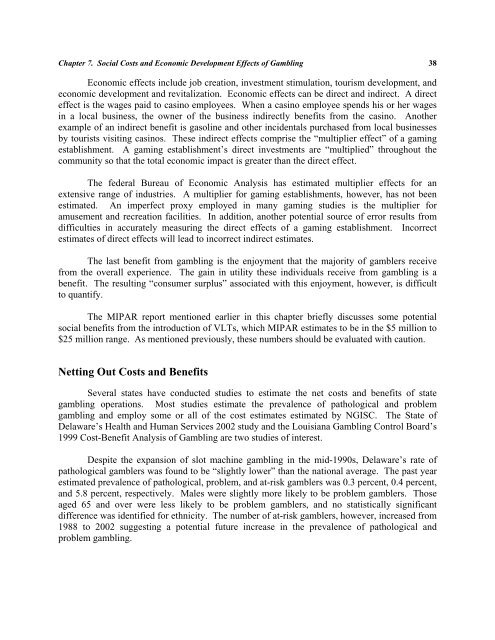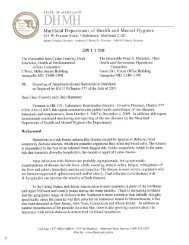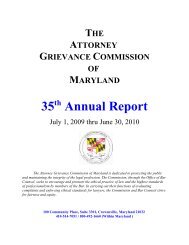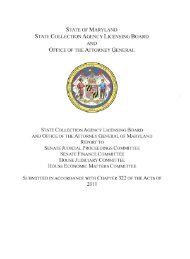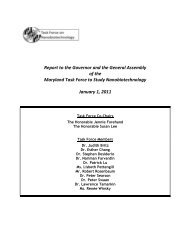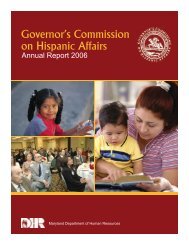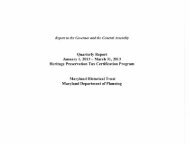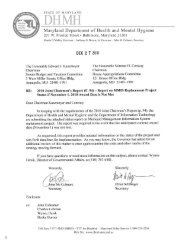Update of the Legislators' Guide To Video Lottery Terminal Gambling
Update of the Legislators' Guide To Video Lottery Terminal Gambling
Update of the Legislators' Guide To Video Lottery Terminal Gambling
You also want an ePaper? Increase the reach of your titles
YUMPU automatically turns print PDFs into web optimized ePapers that Google loves.
Chapter 7. Social Costs and Economic Development Effects <strong>of</strong> <strong>Gambling</strong> 38<br />
Economic effects include job creation, investment stimulation, tourism development, and<br />
economic development and revitalization. Economic effects can be direct and indirect. A direct<br />
effect is <strong>the</strong> wages paid to casino employees. When a casino employee spends his or her wages<br />
in a local business, <strong>the</strong> owner <strong>of</strong> <strong>the</strong> business indirectly benefits from <strong>the</strong> casino. Ano<strong>the</strong>r<br />
example <strong>of</strong> an indirect benefit is gasoline and o<strong>the</strong>r incidentals purchased from local businesses<br />
by tourists visiting casinos. These indirect effects comprise <strong>the</strong> “multiplier effect” <strong>of</strong> a gaming<br />
establishment. A gaming establishment’s direct investments are “multiplied” throughout <strong>the</strong><br />
community so that <strong>the</strong> total economic impact is greater than <strong>the</strong> direct effect.<br />
The federal Bureau <strong>of</strong> Economic Analysis has estimated multiplier effects for an<br />
extensive range <strong>of</strong> industries. A multiplier for gaming establishments, however, has not been<br />
estimated. An imperfect proxy employed in many gaming studies is <strong>the</strong> multiplier for<br />
amusement and recreation facilities. In addition, ano<strong>the</strong>r potential source <strong>of</strong> error results from<br />
difficulties in accurately measuring <strong>the</strong> direct effects <strong>of</strong> a gaming establishment. Incorrect<br />
estimates <strong>of</strong> direct effects will lead to incorrect indirect estimates.<br />
The last benefit from gambling is <strong>the</strong> enjoyment that <strong>the</strong> majority <strong>of</strong> gamblers receive<br />
from <strong>the</strong> overall experience. The gain in utility <strong>the</strong>se individuals receive from gambling is a<br />
benefit. The resulting “consumer surplus” associated with this enjoyment, however, is difficult<br />
to quantify.<br />
The MIPAR report mentioned earlier in this chapter briefly discusses some potential<br />
social benefits from <strong>the</strong> introduction <strong>of</strong> VLTs, which MIPAR estimates to be in <strong>the</strong> $5 million to<br />
$25 million range. As mentioned previously, <strong>the</strong>se numbers should be evaluated with caution.<br />
Netting Out Costs and Benefits<br />
Several states have conducted studies to estimate <strong>the</strong> net costs and benefits <strong>of</strong> state<br />
gambling operations. Most studies estimate <strong>the</strong> prevalence <strong>of</strong> pathological and problem<br />
gambling and employ some or all <strong>of</strong> <strong>the</strong> cost estimates estimated by NGISC. The State <strong>of</strong><br />
Delaware’s Health and Human Services 2002 study and <strong>the</strong> Louisiana <strong>Gambling</strong> Control Board’s<br />
1999 Cost-Benefit Analysis <strong>of</strong> <strong>Gambling</strong> are two studies <strong>of</strong> interest.<br />
Despite <strong>the</strong> expansion <strong>of</strong> slot machine gambling in <strong>the</strong> mid-1990s, Delaware’s rate <strong>of</strong><br />
pathological gamblers was found to be “slightly lower” than <strong>the</strong> national average. The past year<br />
estimated prevalence <strong>of</strong> pathological, problem, and at-risk gamblers was 0.3 percent, 0.4 percent,<br />
and 5.8 percent, respectively. Males were slightly more likely to be problem gamblers. Those<br />
aged 65 and over were less likely to be problem gamblers, and no statistically significant<br />
difference was identified for ethnicity. The number <strong>of</strong> at-risk gamblers, however, increased from<br />
1988 to 2002 suggesting a potential future increase in <strong>the</strong> prevalence <strong>of</strong> pathological and<br />
problem gambling.


